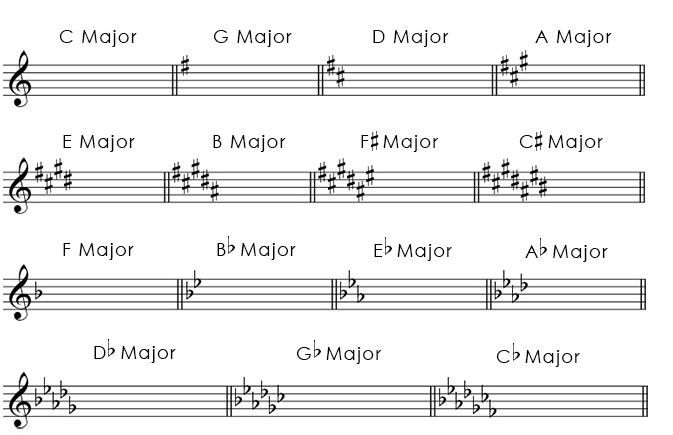A device known as a key signature is used to indicate what particular notes are to be played either higher or lower in a given song. While basic music follows a convention of a simple scale, songs with varying tones may be written with specific keys in order to represent these specialized tones. The tones for the particular key signatures are represented using symbols known as sharps, for notes to be played slightly higher than usual; and flats, for notes to be played slightly lower than usual. Key signatures can be labeled as major or minor, depending on overall composition. However, for the sake of simplicity, we will focus primarily on the major key signatures.
The above example represents a song in the basic key of C Major that contains no sharps or flats. When additional sharps and flats are added, the key signature changes depending on the amount of sharps or flats indicated.
The key signatures above show that a maximum of seven sharps or seven flats can be used. As previously mentioned, every note space where they are placed means that particular note is played higher or lower in the given piece.
Listen to the sound of each of the following examples of notes played in two different key signatures. The first is C major, the second is E major.
To listen to the musical piece below, click the play button [►] in the top left section of the window.
Did you notice how even though the same notes are marked for each key signature, they sound differently? This is specifically what the key signature’s purpose is and how it shapes the way music is composed in order to interpret how a song is to be performed.
One of the easiest ways to identify a key signature is to simply look at a particular sharp or flat in the key signature. Just as we can identify the key of C major by the fact it has no sharps or flats, we can look at a key signature of sharps and determine that the key signature is based on the note that is just above the last sharp depicted.
In the example above, the last sharp is placed on C. One note above C being D, indicates that the key signature is D major.
Key signatures featuring flats are identified a bit differently than those including sharps. In the case of flats, simply take second to last flat that appears in the key signature. The second to last note depicts the letter name of the key signature.
In the example above the second to last flat is placed on the B. Therefore, this indicates the key signature is B flat major. Please note that when only one flat is depicted, this indicates that the key signature is F major. This can be remembered by using the phrase “One F for Flat.”





